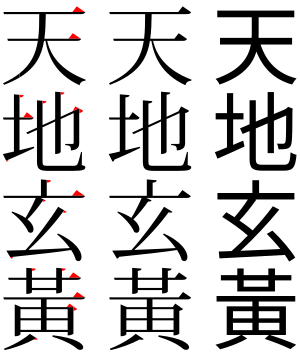Serif facts for kids
| Sans-serif font | |
 |
Serif font |
 |
Serif font (serifs in red) |
A serif is a small, decorative line found at the end of the strokes that make up letters in some fonts. Think of them as little "feet" or "hats" on the letters. If you look at the pictures on the right, you can see these tiny lines on the letters that have serifs.
Fonts are usually divided into two main types: those with serifs and those without. Fonts that do not have these little lines are called sans-serif fonts.
The idea for how we design fonts started a long time ago, back in the 1400s. Early printers used special molds to create letters out of lead.
The way these letters looked was first based on handwriting and letters carved into stone. Over many centuries, people designed countless different fonts. Whether a font has serifs or not is just one of many choices font designers make.
The very first serifs might have come from ancient stone carvings. For example, letters carved at the bottom of Trajan's Column (built around 107-113 AD) clearly show serifs. Because of this, older books often called fonts with serifs "Roman" fonts. The word "serif" itself became common in the early 1800s.
Contents
What is a Serif Font?
A serif font is a typeface that includes small lines or strokes attached to the end of the larger strokes of letters. These small lines are called serifs. They can make text look more traditional or formal.
What is a Sans-Serif Font?
A sans-serif font is a typeface that does not have these small decorative lines at the end of its strokes. The word "sans" means "without" in French, so "sans-serif" literally means "without serifs." These fonts often look more modern and clean.
How Did Serifs Start?
Serifs likely began with ancient Roman stone carving. When scribes painted letters onto stone before carvers cut them, they would often add small finishing strokes to the ends of the letters. This helped to make the letters look more finished and prevent the chisel from slipping. These painted strokes then became part of the carved letters.
Related pages
Images for kids
-
De Aetna, printed by Aldus Manutius
-
1611 book, with arabesque ornament border
-
Title page by John Baskerville, 1757
-
Alphabet by Pierre-Simon Fournier in his Manuel typographique, 1760s
-
Memorial plaque by Eric Gill, c. 1920s
See also
 In Spanish: Gracia (tipografía) para niños
In Spanish: Gracia (tipografía) para niños





















